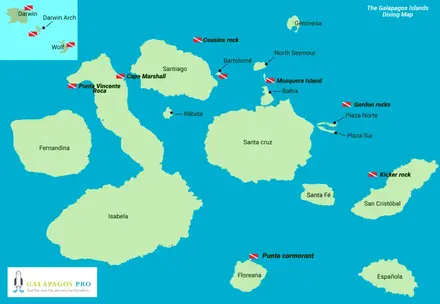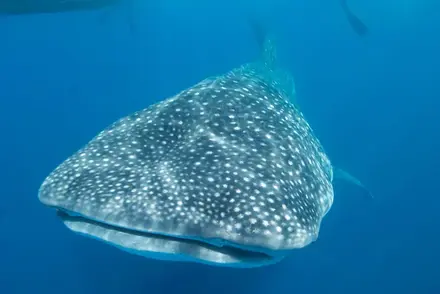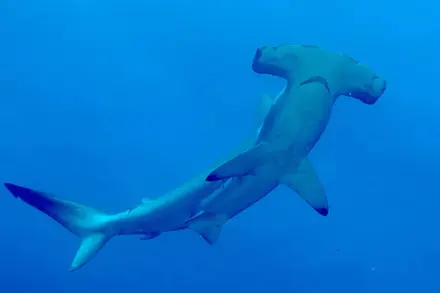The Galapagos Islands, one of every diver's dreams, if not the biggest, because you'll never experience this anywhere else!
Diving in the Galapagos Islands is one of the most spectacular diving experiences in the world. The archipelago's unique geographical location at the intersection of several ocean currents creates an extraordinary diversity of marine life, including many endemic species found nowhere else in the world.
The MV Humboldt Explorer, part of the Explorer Ventures fleet, offers incredible diving in the Galapagos all year round. Following a complete refurbishment in spring 2023, the ship is one of the safest, most modern and comfortable diving cruise ships in the Galapagos Islands
This website uses Google Maps to embed map material. Please note that your personal data may be collected in the process. To view the Google Maps map, please agree that it is loaded from the Google server.
The Humboldt Explorer offers 8 double or twin rooms on the upper or lower decks. All rooms have private en suite bathrooms, individually controlled air conditioning and a television. The air-conditioned saloon on the main deck has an entertainment/media area and a large lounge. Meals are served in the dining area of this saloon, where guests can enjoy the view of the Galapagos Islands. Meals are a mix of American and local cuisine. Other notable areas include the top deck with sun loungers, a bar, an outdoor dining area and a hot tub for warming up between dives.
The Humboldt Explorer also offers a unique 7-night/8-day itinerary; it is the only Galapagos dive vessel to offer 4 days of diving with pelagic fish at Darwin and Wolf Islands. The dive deck is equipped with individual gear lockers, a large camera table and charging station, and a separate freshwater tank for rinsing underwater camera equipment. Diving is done from two large tenders; Nitrox is available for certified divers.

The liveaboard Humboldt Explorer offers incredible diving in the Galapagos all year round. The high season is from July to November, when conditions are colder, currents are stronger and visibility is lower, but this is the best chance to see whale sharks while diving at Darwin and Wolf. The low season is from December to June, when the currents are not as strong, visibility is clearer and the water is warmer. Hammerhead sharks, eagle rays, sea lions, Galapagos and silky sharks and huge schools of fish are generally present all year round.

Central Archipelago, Darwin and Wolf Islands (Baltra - Baltra) 8D/7N
Day 1, Monday: Baltra
Guests fly from mainland Ecuador to the Galapagos Islands, arriving in the late morning. Our dive guides will meet guests at the airport between 11am and 12pm and accompany them to the Galapagos liveaboard. Guests will board the boat, have lunch, organise equipment and listen to safety briefings.
Day 2, Tuesday: Baltra North (2 dives)
- Equipment check.
- 7 and 10 am dives
- Sightings include rays and schools of fish.
- Afternoon shore visit to North Seymour. Walk around North Seymour Island to see the large colonies of blue-footed boobies and frigate birds. Sightings of sea lions and marine iguanas are also common.
- Departure to the northern islands (long transit).
Day 3, Wednesday: Wolf Island (3-4 dives)
- Dives at 10.30 am, 2 pm and 4 pm. Night dive possible.
- Sightings often include hammerhead sharks, whale sharks, eagle rays, sea lions, Galapagos and silky sharks.
- Night anchor on Wolf Island.
Day 4, Thursday: Wolf Island (2 dives)
- 6:30 am and 9:30 am dives
- Crossing to Darwin Island (2 dives)
- 2:00 pm and 4:30 pm dives
- Sightings often include hammerhead sharks, red-lipped batfish, eagle rays, sea lions, Galapagos sharks and silky sharks.
Day 5, Friday: Darwin Island (4 dives)
- 6:30, 10:30 am, 2 and 4:30 pm dives
- Sightings often include hammerhead sharks, whale sharks (in season), eagle rays, Galapagos sharks and silky sharks.
- Crossing to Wolf Island
Day 6, Saturday: Wolf Island (3 dives)
- 6:30, 9:00 and 11:00 am dives
- Sightings often include hammerhead sharks, whale sharks (in season), eagle rays, Galapagos sharks and silky sharks.
- Long transit to Cousin's Rock (20+ hours)
Day 7, Sunday: Cousin's Rock (1-2 dives)
- 6:30 and 9:30 am, dives (number of dives depending on travelling time from Wolf Island)
- This is a great macro dive with an excellent chance of seeing seahorses, sea lions and eagle rays. Lunch will be served on the way to Santa Cruz (3 hours). Travel by bus to the Santa Cruz Highlands to visit the giant tortoises in their natural habitat.
- Visit the town of Puerto Ayora and the Darwin Centre on your own. Dinner on your own in Puerto Ayora.
- Return to the Humboldt Explorer at 20:30 pm
Day 8, Monday: Baltra
Disembark the ship at 9 am. Transfer to the airport.
Marine life: The Galapagos Islands are home to the world's only marine iguanas and the northernmost living penguin. Coral reefs share the same waters as fur seals. The Galapagos Islands are one of the few places where pelagic species such as tuna, manta rays and hammerhead sharks can be observed close to shore. No other place in the world has such a diversity of marine life.
In addition, the geological and biological processes of the Galapagos Islands have helped to create a wide variety of habitats compared to other marine areas in the eastern Pacific. Coastal areas include vertical cliffs, sandy beaches, rocky shores, mangroves, coral reefs, lagoons and hypersaline pan habitats. Submarine mountains, plateaus, ridges and valleys provide habitat for a range of marine communities, while the open oceans attract populations of pelagic fish.
Please note that these Galapagos dive itineraries are examples only and are subject to change at the captain's discretion depending on local regulations, weather and logistics. Currently, the itinerary includes the same islands each week. However, the order of island visits is dictated by the Galapagos National Park and may vary weekly.

Galapagos Special Itinerary B - Extended Specialty Itinerary (Baltra - Baltra) 11D/10N
Day 1: Baltra
Guests fly from the Ecuadorian mainland to the Galapagos Islands and arrive in the late morning. The dive guides meet the guests at the airport and accompany them to the Humboldt Explorer. The guests board the ship, have lunch and listen to the briefings.
Day 2: Baltra North (2 dives)
6:30 and 9:30 dives.
Sightings include rays and schools of fish.
Afternoon visit to North Seymour: Walk around North Seymour Island to see the large colonies of blue-footed boobies and frigate birds. Sightings of sea lions and marine iguanas are also common.
Departure to the northern islands (long transit).
Day 3: Cabo Marshall (3-4 dives)
Sightings often include manta rays, barracudas and many more.
Day 4: Punta Vincente Roca & Cabo Douglas (2-3 dives)
1 dive in the morning in Punta Vicente Roca. Sightings often include mola-mola, turtles and macro life.
1 or 2 afternoon dives in Cabo Douglas. Sightings also include marine iguanas.
Day 5: Darwin Island (3 dives)
10:30, 2:00 and 4:30 dives.
Sightings often include hammerhead sharks, whale sharks (in season), eagle rays, Galapagos sharks and silky sharks.
Day 6: Wolf Island (4 dives)
6:30, 10:30, 2:00 and 4:30 dives.
Sightings often include hammerhead sharks, whale sharks (in season), eagle rays, sea lions, Galapagos sharks and silky sharks.
Day 7: Wolf & Darwin Islands 2 dives
6:30, 10:30 dives in Wolf. Crossing to Darwin.
2:00 and 4:30 dives in Darwin.
Sightings often include hammerhead sharks, whale sharks (in season), eagle rays, Galapagos sharks and silky sharks.
Day 8: Darwin Island (4 dives)
6:30, 10:30, 2:00 and 4:30 dives.
Sightings often include hammerhead sharks, whale sharks (in season), eagle rays, Galapagos sharks and silky sharks.
Day 9: Wolf Island (3 dives)
6:30, 10:30, 2:00 dives.
Sightings often include hammerheads, whale sharks (in season), eagle rays, Galapagos sharks and silky sharks. Long transit to Cousin's Rock.
Day 10: Cousin's Rock (1-2 dives)
6:30 and 9:30 dives (number of dives depending on travelling time from Wolf Island).
This is a great macro dive with an excellent chance of seeing seahorses, sea lions and eagle rays. Lunch will be served on the way to Santa Cruz (3 hours).
In the afternoon, you will travel by bus to the Santa Cruz Highlands to visit the giant tortoises in their natural habitat.
Transfer to the town of Puerto Ayora. Dinner on your own in Puerto Ayora. Return to the Humboldt Explorer at 20:30 hrs
Day 11: Baltra
Price on request
Leave the ship at 8.30 am. Transfer to the airport.
Your Galapagos liveaboards include everything from sharks to nudibranchs and more. The islands are best known for amazing shark dives around the Wolf and Darwin Islands. These small and remote islands are best reached by liveaboard dive boats. Your diving experience here usually includes Galapagos sharks, silky sharks and many schools of hammerhead sharks cleaned by king angelfish. Sea turtles, schools of tuna, eagle rays and sea lions are very common, and from June to November it is very possible to see a whale shark. All the islands you travel to are amazing locations for underwater photography.
Macro photographers will get their fill of seahorses, barnacles, coral shoals and many others. At many dive sites there is an abundance of rays (including spotted rays, marble rays, golden rays and stingrays) along with sea lions, sea turtles, schools of grunts and snappers. The diversity of life in these waters is unrivalled anywhere else, with thick schools of the native brown striped salema, snappers, groupers, chevron barracudas and giant sea turtles.
The last dive takes place on the last day of the trip. Divers are advised to wait 24 hours after the last dive before flying.
Sample itineraries and maps are for illustrative purposes only. The exact route and locations visited may change depending on local regulations, guest experience, weather and logistics and are at the captain's discretion.
Lower Deck Staterooms
- 2 single or 1 double bed,
- en-suite bathroom,
- adjustable air conditioning,
- 2 guests
Main Deck Staterooms
- 1 double bed,
- en-suite bathroom,
- adjustable air conditioning,
- 2 guests
Included: VAT, alcoholic drinks, soft drinks, tea & coffee, drinking water, snacks, full board (all meals), dive packages, towels for use on deck, cabin towels, WiFi.
Required extras: cost of hyperbaric chamber (35 USD), national park fees (100-200 USD), fuel surcharge (150-220 USD), visa and fees (20 USD).
Optional extras: tips, airport transfers, regional flights, rental equipment, Nitrox (150 USD), Nitrox course (170 USD), shore excursions, snorkelling set.
Prices for rental equipment:
Rental equipment is available on this vessel. Please indicate what you need on the booking form. Details below of what is included and the additional prices.
- 15 litre tanks 130 USD
- Regulator 90 USD
- BCD 90 USD
- Fins 50 USD
- Mask 25 USD
- Nitrox refills 150 USD
- Nitrox bottle included
- Snorkel set 25 USD
- Signal buoy included
- Dive computer 100 USD
- Complete equipment (with: regulator, BCD, wetsuit) 250 USD
- Wetsuit 75 USD
Air temperature: Temperatures vary throughout the year between around 21.8 °C in September and 26.3 °C in March.- Water temperature: Water temperatures range between 21.1 °C in September and 26.4 °C in March, which provides ideal conditions for diving activities
- Rainfall: The rainiest months are February and April, while September is the driest month.
An archipelago of volcanic origin in the eastern Pacific, located around 1,000 kilometres off the coast of Ecuador. Geographically they belong to South America, politically to Ecuador.
Consists of 13 main islands, 6 smaller islands and over 100 rocks and islets.
Famous islands for divers:
Isabela
Santa Cruz
San Cristóbal
Wolf
Darwin
Population
Around 30,000 people live on the inhabited islands, mainly on Santa Cruz, San Cristóbal, Isabela and Floreana.
The population lives mainly from tourism, fishing and small services.
Strong focus on education and sustainability through environmental initiatives.
Religions
As in the rest of Ecuador, the majority of the population is Roman Catholic.
Religious festivals are part of the local culture, but have less influence than nature and environmental issues.
Economic situation
Tourism is by far the most important economic sector, especially ecotourism and diving tourism.
Strict regulations to protect the national park and UNESCO World Heritage Site.
Fishing is severely restricted; sustainable use of resources is promoted.
Significance for Ecuador
The Galápagos Islands are one of the world's most important nature travel destinations.
They are considered the birthplace of the theory of evolution (Charles Darwin) and a model region for sustainable tourism.
They are a prestigious project for Ecuador in terms of nature conservation and international co-operation.
Economic influence of the diving industry
Diving tourism is highly specialised and generates high revenues:
Liveaboard vessels
Certified guides
Marine park fees
Photography and expedition tourism
Positive effects: jobs for boat crews, dive guides, hotels, suppliers
Strengthening local initiatives for marine conservation
Linking science and tourism
Challenges: Limited number of licences for liveaboards
High costs and logistical effort
Strict regulations for entry, equipment, waste disposal
Why the Galápagos Islands are a favourite destination for divers
Guaranteed big fish: hammerhead sharks, Galápagos sharks, whale sharks, manta rays
Unique underwater world with marine iguanas, penguins and sea lions
Extremely high visibility in the dry season (June-December)
Current-rich, challenging dive sites for experienced divers
Diving at remote spots such as Darwin and Wolf only possible by liveaboard
Combination of adventure, science and nature experience


